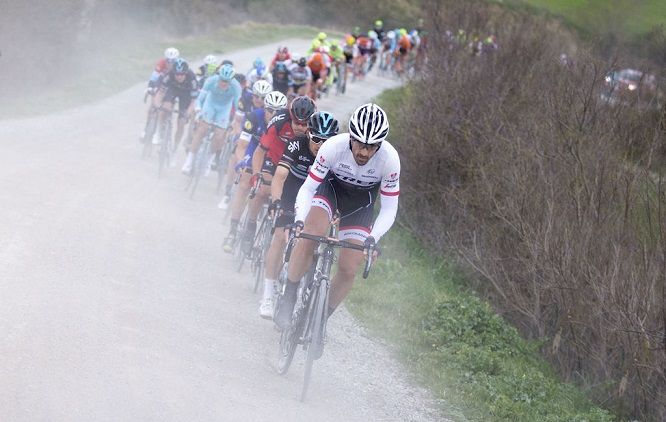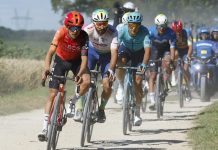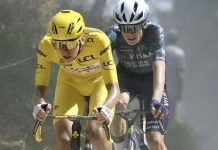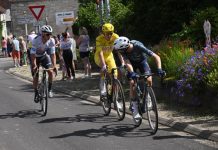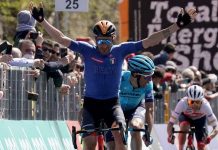On 4 March, Siena will host the the men’s Strade Bianche race, promoted to the UCI WorldTour calendar in 2017.
This year’s winner Fabian Cancellara achieved his third Strade Bianche success, and with it, the honour of having one sector of the gravel roads, Sector 8 of Monte Sante Marie, dedicated to his name.
The main differences with last year’s course are in the first kilometres, where the Bagnaia climb on gravel roads marks its return after the 2014 and 2015 editions. The course will then see a harder white roads sector in the first part and the cancellation of the paved Passo del Rospatoio climb.
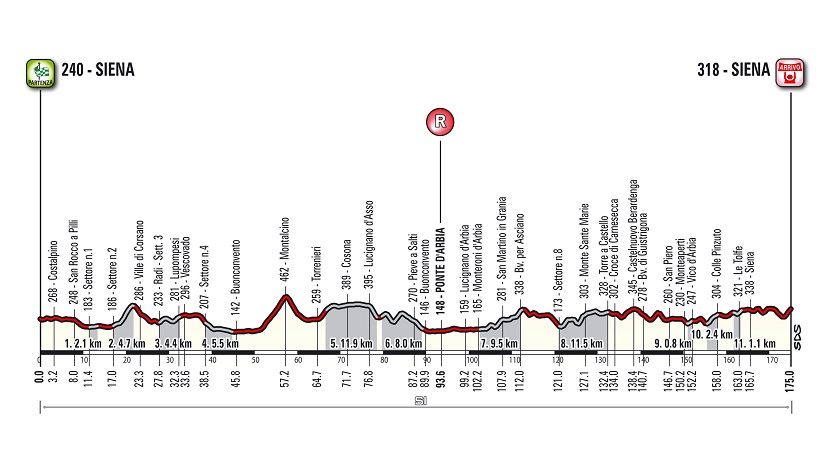
A twisty and undulating course, with no long climbs but with punchy hills, most significantly on the unpaved parts. There are roughly 62km of gravel roads, appearing in 11 sectors.
Starting from Siena (Stadium/Medicean Fortress area), the first undulating kilometres are on tarmac before reaching the 2.1km gravel Sector 1 at km 11, which is perfectly straight and always slightly uphill.
After few kilometres the riders will face Sector 2 (4.7km), the course’s first real challenge with a short descent and a long climb with parts at over 10%.
The course will then go through Radi, where Sector 3 starts (4.4km, second part of the original Sector 1 of the first editions) and immediately after Sector 4, one of its classic gravel sectors (5.5km, featured in the course since its first edition) with no significant gradient and leading to Buonconvento.
After few kilometres the second climb of the day starts: the Montalcino (4km at 5%). After Torrenieri the riders will face Sectors 5 (11.9km) and 6 (8km) with only 1km of tarmac in between them. Both are hard, hilly, very punchy and with many bends, climbs and descents.
After the second passage through Buonconvento the feed station will be positioned in the area of Ponte d’Arbia. Soon the route reaches Monteroni d’Arbia, which marks the beginning of Sector 7 of San Martino in Grania (9.5km) in the middle of the Crete Senesi. It’s a long sector with continuous up and downs in the first part, ending up with a twisting climb before meeting the tarmac again.
In Ponte del Garbo (Asciano) gravel Sector 8 begins. At 11.5km it’s the hardest of the race, mostly uphill and characterised by tough hills, the most important being those close to Monte Sante Marie, which face steep gradients on both climbs and descents over short distances.
After Castelnuovo Berardenga there’s a very short, flat section of gravel (300m), before facing, after Monteaperti, Sector 9 which is only 800m long, but with a double digit gradient ramp before rejoining the tarmac in Vico d’Arbia and going to paved road through Pieve a Bozzone.
Next comes the penultimate sector (Sector 10, 2.4km) on the climb toward Colle Pinzuto (with gradients up to 15%). After a few kilometres the riders will face the last sector (Sector 11, 1.1km) which features a sequence of a demanding descent followed by a very punchy climb (max 18%) that ends up at the Tolfe. From here only 12km separate the riders from the finish in Piazza del Campo, Siena.
The demanding final kilometres, with gradients up to 16%, approach the city of Siena along broad, straight sections of road, connected by sweeping curves, first descending, and then climbing slightly. 2km from the finish line, the route joins Via Esterna di Fontebranda, where the gradient touches 9%.
900m from the finish line, the race route passes beneath Fontebranda Gate where the road surface becomes paving slabs. The gradient exceeds 10% until 500m from the finish line, reaching its highpoint of 16% in Via Santa Caterina. A sharp right hand turn leads to Via delle Terme, and then Via Banchi di Sotto. With 300m to go, the road continues to climb slightly then, 150m from the line, a right turn leads into Via Rinaldini. The route enters the Piazza del Campo just 70m from the finish line. The final 30m descends at a gradient of 7% and the finish line itself is flat.
Mauro Vegni, RCS Sport Cycling Director, said: “This weekend in Terre di Siena is now a traditional event in the international cycling calendar. The good work done in recent years by the Municipal Administration and all the other institutions involved, has produced its fruits. This is demonstrated by the constant increase of numbers, media coverage and public presence. The best athletes will be at the start of the one-day races: the women’s race, now in its third edition, and the men’s race – part of the WorldTour calendar from 2017. We believe that the two races, together with the Gran Fondo the following day, all within this beautiful landscape, are distinctive and unique elements of this great cycling weekend. The goal is to continue growing, year after year, and to bring these races to the level of excellence they deserve.”


